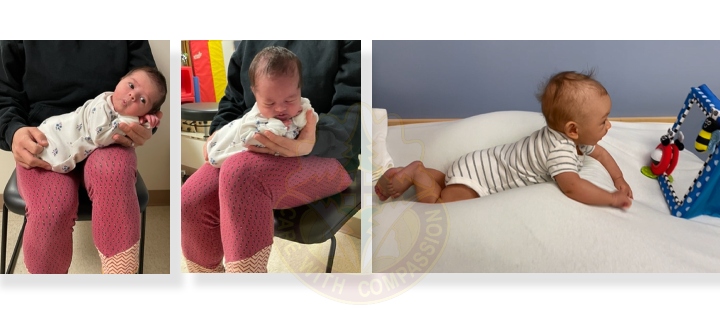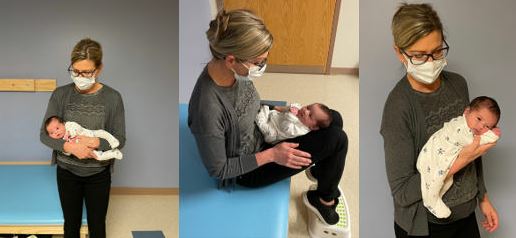Guiding Your Baby Through Motor Development in the First Year

Since the inception of the Back to Sleep campaign (now called Safe to Sleep) in the early 1990’s, there has been a drastic increase in the incidence of gross motor delay, torticollis (neck muscle tightness and movement preference), and plagiocephaly and brachycephaly (the last two are medical terms referring to flatness on the sides or back of the head). Research has demonstrated an association between these impairments and later concerns in development of motor, cognitive (thinking/problem solving), language, social, and perceptual skills.
- Babies learn about their own bodies and about the world through movement and exploration. This is how they gain knowledge and learn how to interact with the world. In your baby’s first year they are dependent on you to facilitate positioning and movement during play and daily activities.
- In your baby’s first year they are dependent on you to facilitate positioning and movement during play and daily activities.
Our GOAL is to EMPOWER you with strategies you can implement early to protect your baby’s muscles and skeleton and to enable your baby to be a successful, active participant in their world. Our FOCUS is on PREVENTION.
There are several tutorial videos embedded within this webpage demonstrating strategies to optimize development. There are also several reliable links with additional information. To open a link in a new tab on a smartphone, long-press (touch and hold) the link and then select "Open in new tab" or "Open in new window" from the menu that appears. On a computer/laptop right click on the link and select “open in new tab” or “open in new window”.
Check out Zero to Three’s all new Baby Brain Map which is “an interactive tool detailing key stages in brain development to help caregivers and professionals explore how early experiences have the power to shape lifelong wellbeing”
Factors That Increase Risk of Motor Delay or Movement Impairment:
- Increased use of infant positioners such as infant car seat carriers, bouncers, swings, and rockers
- Decreased floor time, especially tummy time
What Can Caregivers Do:
- Decrease use of Infant positioners
- Increase floor time and tummy time
- Change your baby’s position frequently
- Provide varied movement experiences
- Set up the environment to encourage more movement opportunities
Babies must be placed on their back for sleep. But, since babies spend a lot of time sleeping during these first few months of life, they need opportunities to move freely in various positions to promote their ability to:
- Build their muscle strength
- Work out muscle imbalances that may come about from cramped positioning the last few months in the cozy womb
- Explore their environment and learn about their world
While it is recommended to keep track of your baby’s milestones, keep in mind that all babies develop at a different pace with a wide range of “typical development”. What is more important is that your baby is steadily progressing without significant movement preferences that can result in restricted movement patterns, muscle tightness, and muscle imbalances. Muscle tightness and muscle imbalance early in life can have a negative impact even through adulthood.
Resources to Monitor Motor Development:
https://pathways.org/baby-milestones-calendar/
- Motor Milestones: Activities, milestones, and games based on baby’s date of birth
- Also includes several videos to help baby with various developmental skills
https://pathways.org/quick-links/early-detection-early-intervention/
- Early Detection and Early Intervention
- “The goal of early detection is to have babies learn proper movement at its appropriate time of development. Research suggests it takes between 300-350 repetitions to build a new motor or movement pattern; however, it can take 3000-5000 repetitions to ‘re-train’ the proper movement. This means that it is much easier to learn to do something right the first time than try to correct something after it has already been learned.”
https://childmuscleweakness.org/materials-for-families/#zero-six
- Monitoring Motor Milestones and When to Speak to your baby’s health care practitioner about Concerns of Weakness
If you have concerns about your baby’s development, please speak with your primary care provider.

Optimal Movement Strategies
Evidence-based strategies that promote early motor development focus on:
- Promoting variety in movement and frequent changes in positions
- Starting with short amounts of time in different positions and gradually build on this as your baby gets used to new positions.
- Promoting self-initiated and goal-directed movement: place toys slightly out of reach to encourage your baby to move toward them. Once your baby has achieved this goal, it’s time to help your baby progress. Next time you place the toy on the floor position it slightly further away to encourage further movement. Try not to place it so far away that your baby gets frustrated or gives up. Try to provide a “just right” challenge.
- Fun and engaging activities, with a playful purpose, while providing a “just-right” challenge to promote the next step – keep it fun, try to avoid moments of frustration. If we start this way at the beginning this is much easier!
- Providing LOTS of repetition to practice skills. Research suggests it takes between 300-350 repetitions to build a new motor or movement pattern.
While there is an abundance of child development information on the web, we wanted to provide concise evidence-based strategies to guide you on strategies to optimize typical motor development in your baby’s first year of life. Please check back as additional videos and pictures will be added to guide you on strategies optimizing motor development
Infant Positioners
(Examples: car seat carriers, strollers, bouncers, swings, rockers, loungers)
- Minimizing use will help your baby avoid “CONTAINER SYNDROME”, avoid a flat head, provide opportunities for your baby to move in various directions, and help baby work out any postural asymmetries that are often commonly found in newborns
- Carry your baby as often as possible when out of the home instead of keeping baby in an infant carrier
- Vary your baby’s position as often as possible
- Minimize use of infant positioners to 15-20 minutes at a time, a few times a day
- While your baby must be in a car seat while driving, try to take frequent breaks when on lengthy road trips. During drive breaks, remove your baby from the car seat to take pressure off their head and allow them to stretch their muscles.
- Alternative options (listed & pictured below) for promoting proper positioning and movement while keeping baby safe:
- Baby Wraps and other soft structured body wearing carriers
- Pack-N-Play / Play Pens / Bassinets
- Baby Gates / Play Yards

See this link for baby wearing tips: https://www.healthline.com/health/parenting/baby-wearing#carrier-types and this link to ensure you are positioning the hips well for joint protection: https://hipdysplasia.org/baby-wearing/ “The M-position is a natural clinging position for infants – also known as the Spread-Squat, or Jockey Position. This is recommended as a healthy habit with the thighs spread around the mother’s torso and the hips bent so the knees are slightly higher than the buttocks with the thighs supported”
Speaking of hip safe positioning, see this link for hip safe swaddling strategies: https://hipdysplasia.org/swaddling-statement/
https://www.candokiddo.com/news/baby-gear
- Describes precautions associated with use of Infant Positioners such as infant car seat carriers, bouncers, swings, and rockers
Playful Positioning/Tummy Time:
- Vision drives movement!
- Use a visually interesting toy (black & white / bright, contrasting colors) or a person (engaging, smiling, singing, talking) to stimulate movement and to help babies hold or balance in specific postures.
- Tummy Time Tips:
- Start tummy time on your chest within a few hours after birth. Supervised tummy time should be done at every opportunity throughout the day. Break it up into short spurts - even 30-60 seconds is beneficial! Increasing the number of opportunities throughout the day helps your baby tolerate the position faster and helps your baby increase muscle strength for improved tummy time skills. Once their strength has improved they start to tolerate it even more. When there is time, try several repetitions of tummy time in a row, with breaks in between; this is another strategy to help them increase their tolerance of and strength in the position. Just like when we do exercises to build our strength!
- It helps to vary tummy time positions – on your lap, in your arms, on your chest, on a large exercise ball, on a Boppy pillow, or on a foam wedge - and don’t forget that flat, firm surfaces like the floor, a floor mat, or a firm mattress or cushion are still important to practice every day! All tummy time positions count.
- When moving your baby into and out of tummy time, guide them by rolling. This helps build your baby’s muscle strength and tolerance of the new position (works them slowly into the position). Don’t forget to practice rolling over baby’s left and right arms to promote balanced skills. See video links below on how to help with rolling.
- Keep tummy time a positive experience and end it as a positive experience as often as possible so it’s remembered as a positive experience. Starting this immediately after baby is born will make this easier.
- If baby is inclined a bit in tummy time, this will be easier, so while it’s also important to have baby practice on flat, firm surfaces, give baby time to practice when inclined as well. Remember – variety! And practice!
- Starting tummy time early will help your baby attain the recommended 60-90 minutes a day by 3-6 months of age.
- Your infant must be supervised and awake during tummy time.
- Free play on flat, firm surfaces on baby’s back and side-lying are also important positions.
- Remember: Variety! Change your baby’s position frequently.
Alternate your baby’s position throughout the day to encourage baby to look both ways and if baby has a restriction or preferred position, focus more on the side of restriction or non-preferred side:
-
Alternate the end of the crib in which baby is positioned and the end of the changing table in which you place your baby’s head. If baby has a preferred side to look, make sure baby is positioned so the non-preferred side is more interesting (for example, if in same room with parent, parent should be on the non-preferred side. A window or the door you enter from can be on the non-preferred side.)
-
Alternate the arm you hold your baby with
-
Alternate positions of toys placed on the side of the car seat, stroller, swing
-
Alternate feeding position
- Position yourself and other items/people of interest on the side of baby’s restriction if there is one. Try to keep the preferred side uninteresting.
View tutorial videos from Madigan’s Department of Pediatrics by clicking on the images below. Videos include strategies for optimizing tummy time, rolling, full neck movement all directions, visual tracking, reaching, grasping, transitioning to sit, and optimal positioning for social engagement for young babies starting from birth.
Other Tummy Time Tips:
Can Do Kiddo: How to help your infant roll
https://m.youtube.com/watch?v=z5kVsWptIwQ
• Pathways.org: SEVERAL EXCELLENT VIDEOS covering many topics on this link:
https://pathways.org/growth-development/0-3-months/watch/
Includes:
• “Tips to Make Tummy Time Easier”
• “Meeting Milestones – How to Help Baby Lift & Hold Head Up”
• “Tummy Time Troubles”
• “Baby Rolling Over During Tummy Time”
• “Meeting Milestones – How to Help Baby Visually Track Objects”
• “Parents’ Guide to Working Out with Baby”
Health Link BC: Importance of Tummy Time for Baby’s Development
• https://www.healthlinkbc.ca/pregnancy-parenting/parenting-babies-0-12-months/baby-growth-and-development/importance-tummy-time
• Children’s Healthcare of Atlanta Tummy Time Tools: https://www.choa.org/~/media/files/Childrens/about-us/newsroom/english/tummy-time-tools-english.pdf
TORTICOLLIS & PLAGIOCEPHALY (Neck Restrictions / Flattened Heads):
Do not be alarmed by the mention in the video of a helmet for treating the flat spot on the head. For babies under 6 months old there is still a lot of time for correction with the strategies recommended in these videos and other individualized strategies that will be provided at your physical therapy visit if physical therapy was recommended by your baby’s provider.
See videos under playful positioning section above for additional strategies
It is especially important for babies with neck restrictions, movement asymmetries (postural preferences), and/or flattened heads to limit time in infant positioners like strollers, car seat carriers, swings, bouncers, and rockers as much as possible. Only have your baby sleep in a crib or bassinet. Limit the use of the car seat carrier for riding in the car. Opt for carrying your baby or baby wearing when possible. See Infant Positioners above for information on baby wearing.
Your baby must continue to sleep on his/her back until they are rolling on their own in the crib, but when awake and supervised change your baby’s position frequently: lots of supervised tummy time, free time on his/her back, rolling, side-lying, carrying your baby in different positions.
Encourage your baby to look different directions so they are not keeping their head in the same position. Use faces and/or colorful toys to slowly encourage your baby to look as far as possible to the non-preferred side – implement lots of repetitions several times throughout the day, but do a little at a time so as not to overstimulate your baby or lose interest. Compare your baby’s ability to turn to the left or right as far as possible to ensure baby can turn both directions equally well. If not, work the restricted or non-preferred side more frequently.
Use alternate positioning to encourage baby to look more frequently toward the side of restriction or non-preferred side. See examples under the bullet titled “Alternate you baby’s position” at the end of the “Playful Positioning” section above
AFTER THE EARLY INFANT PERIOD (3 months old and older)
Please check back; additional videos and links may be added.
Promote Rolling:
Transition to Crawling:
Transition to Walking:
PLAY to PROMOTE DEVELOPMENT
ActiveMatters.org is a great website dedicated to physical activity for babies and young children. ·
Move with me from Birth to Three: Leap BC, Literacy, Education, Activity and Play https://www.decoda.ca/wp-content/uploads/MOVE_Family_Resource.pdf
- · This downloadable PDF provides extensive information for promoting motor development in birth to three year old children
- Pages 14-15: Physical Activity for babies from birth to 3 years old
- Pages 22-45: Various games and play strategies with focus on physical activities to promote overall development